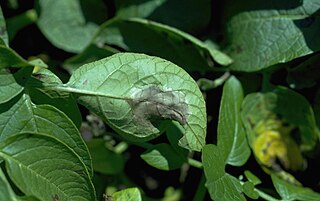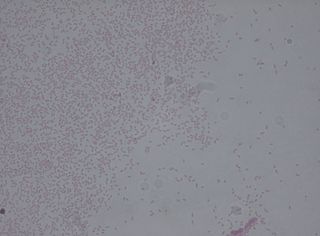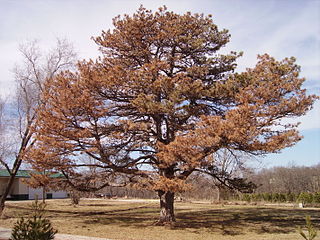Gallery
- Chestnut blight
- Brown felt blight
- Potato late blight
- Fire blight appletree fruit
- Three dead Bermuda cedars in 2019
Blight is a specific symptom affecting plants in response to infection by a pathogenic organism.
Blight is a rapid and complete chlorosis, browning, then death of plant tissues such as leaves, branches, twigs, or floral organs. [1] Accordingly, many diseases that primarily exhibit this symptom are called blights. Several notable examples are:[ citation needed ]
On leaf tissue, symptoms of blight are the initial appearance of lesions which rapidly engulf surrounding tissue. However, leaf spots may, in advanced stages, expand to kill entire areas of leaf tissue and thus exhibit blight symptoms.
Blights are often named after their causative agent. For example, Colletotrichum blight is named after the fungus Colletotrichum capsici , and Phytophthora blight is named after the water mold Phytophthora parasitica . [11]
When blights have been particularly vast and consequential in their effects, they have become named historical events, such as the 19th Century Potato Blight, also known locally from its primary consequence as the Great famine, the Great Famine of Ireland, and Highland Potato Famine, and the near extinction of the Bermuda cedar during the 1940s and 1950s in the event described as The Blight or The Cedar Blight. [12] [13] [14] [15] [16] [17] [18]

Phytophthora infestans is an oomycete or water mold, a fungus-like microorganism that causes the serious potato and tomato disease known as late blight or potato blight. Early blight, caused by Alternaria solani, is also often called "potato blight". Late blight was a major culprit in the 1840s European, the 1845–1852 Irish, and the 1846 Highland potato famines. The organism can also infect some other members of the Solanaceae. The pathogen is favored by moist, cool environments: sporulation is optimal at 12–18 °C (54–64 °F) in water-saturated or nearly saturated environments, and zoospore production is favored at temperatures below 15 °C (59 °F). Lesion growth rates are typically optimal at a slightly warmer temperature range of 20 to 24 °C.

Fire blight, also written fireblight, is a contagious disease affecting apples, pears, and some other members of the family Rosaceae. It is a serious concern to apple and pear producers. Under optimal conditions, it can destroy an entire orchard in a single growing season.

Erwinia is a genus of Enterobacterales bacteria containing mostly plant pathogenic species which was named for the famous plant pathologist, Erwin Frink Smith. It contains Gram-negative bacteria related to Escherichia coli, Shigella, Salmonella, and Yersinia. They are primarily rod-shaped bacteria.
Rebecca J. Nelson is an American biologist and a professor at Cornell University and a MacArthur Foundation Fellow.

Thomas Jonathan Burrill was an American botanist, plant pathologist, and college administrator who first discovered bacterial causes for plant disease. He introduced Erwinia amylovora as the causal agent of pear fire blight.

Pantoea agglomerans is a Gram-negative bacterium that belongs to the family Erwiniaceae.
Alternaria triticina is a fungal plant pathogen that causes leaf blight on wheat. A. triticina is responsible for the largest leaf blight issue in wheat and also causes disease in other major cereal grain crops. It was first identified in India in 1962 and still causes significant yield loss to wheat crops on the Indian subcontinent. The disease is caused by a fungal pathogen and causes necrotic leaf lesions and in severe cases shriveling of the leaves.

Alternaria solani is a fungal pathogen that produces a disease in tomato and potato plants called early blight. The pathogen produces distinctive "bullseye" patterned leaf spots and can also cause stem lesions and fruit rot on tomato and tuber blight on potato. Despite the name "early," foliar symptoms usually occur on older leaves. If uncontrolled, early blight can cause significant yield reductions. Primary methods of controlling this disease include preventing long periods of wetness on leaf surfaces and applying fungicides. Early blight can also be caused by Alternaria tomatophila, which is more virulent on stems and leaves of tomato plants than Alternaria solani.
Plant disease epidemiology is the study of disease in plant populations. Much like diseases of humans and other animals, plant diseases occur due to pathogens such as bacteria, viruses, fungi, oomycetes, nematodes, phytoplasmas, protozoa, and parasitic plants. Plant disease epidemiologists strive for an understanding of the cause and effects of disease and develop strategies to intervene in situations where crop losses may occur. Destructive and non-destructive methods are used to detect diseases in plants. Additionally, understanding the responses of the immune system in plants will further benefit and limit the loss of crops. Typically successful intervention will lead to a low enough level of disease to be acceptable, depending upon the value of the crop.
This article summarizes different crops, what common fungal problems they have, and how fungicide should be used in order to mitigate damage and crop loss. This page also covers how specific fungal infections affect crops present in the United States.
Copper pesticides are copper compounds used as bactericides, algaecides, or fungicides. They can kill bacteria, oomycetes and algae, and prevent fungal spores from germinating. Common forms of fixed copper fungicides include copper sulfate, copper sulfate pentahydrate, copper hydroxide, copper oxychloride sulfate, cuprous oxide, and copper octanoate.

A wilt disease is any number of diseases that affect the vascular system of plants. Attacks by fungi, bacteria, and nematodes can cause rapid killing of plants, large tree branches or even entire trees.
The Harovin Sundown pear is a late-season fresh market pear with good storage capability. It is highly productive with no biennial bearing. The tree has excellent resistance to fire blight. This new cultivar, developed by Agriculture and Agri-Food Canada (AAFC) at its Research Centers in Harrow and Vineland Station, Ontario, Canada, is recommended by the Ontario Tender Fruit Producers' Marketing Board for general planting in Ontario. It is protected under Canadian Plant Breeders Rights legislation.

Grey leaf spot (GLS) is a foliar fungal disease that affects maize, also known as corn. GLS is considered one of the most significant yield-limiting diseases of corn worldwide. There are two fungal pathogens that cause GLS: Cercospora zeae-maydis and Cercospora zeina. Symptoms seen on corn include leaf lesions, discoloration (chlorosis), and foliar blight. Distinct symptoms of GLS are rectangular, brown to gray necrotic lesions that run parallel to the leaf, spanning the spaces between the secondary leaf veins. The fungus survives in the debris of topsoil and infects healthy crops via asexual spores called conidia. Environmental conditions that best suit infection and growth include moist, humid, and warm climates. Poor airflow, low sunlight, overcrowding, improper soil nutrient and irrigation management, and poor soil drainage can all contribute to the propagation of the disease. Management techniques include crop resistance, crop rotation, residue management, use of fungicides, and weed control. The purpose of disease management is to prevent the amount of secondary disease cycles as well as to protect leaf area from damage prior to grain formation. Corn grey leaf spot is an important disease of corn production in the United States, economically significant throughout the Midwest and Mid-Atlantic regions. However, it is also prevalent in Africa, Central America, China, Europe, India, Mexico, the Philippines, northern South America, and Southeast Asia. The teleomorph of Cercospora zeae-maydis is assumed to be Mycosphaerella sp.

Southern corn leaf blight (SCLB) is a fungal disease of maize caused by the plant pathogen Bipolaris maydis.
Plant pathology has developed from antiquity, but scientific study began in the Early modern period and developed in the 19th century.

Collar rot is a symptomatically described disease that is usually caused by any one of various fungal and oomycete plant pathogens. It is present where the pathogen causes a lesion localized at or about the collet between the stem and the root. The lesions develop around the stem eventually forming a "collar". Observationally, collar rot grades into "basal stem rot", and with some pathogens is the first phase of "basal stem rot" often followed by "root rot". Collar rot is most often observed in seedings grown in infected soil. The pathogens that cause collar rot may be species or genera specific. But generalist pathogens such as Agroathelia rolfsii are known to attack over 200 different species. While bacteria caused collar rot is not common, trees infected with Fire blight may develop collar rot. Non-parasitic collar rot may be caused by winter damage.
Trunk injection or endotherapy also known as vegetative endotherapy, is a method of target-precise application of pesticides, plant resistance activators, or fertilizers into the xylem vascular tissue of a tree with the purpose of protecting the tree from pests, or to inject nutrients to correct for nutrient deficiencies. This method largely relies on harnessing the tree's vascular system to translocate and distribute the active compounds into the wood, canopy and roots where protection or nutrition is needed.
Robert S. Dickey was an American phytopathologist, professor emeritus of Plant Pathology at the Cornell University and the namesake of the bacterial genus Dickeya.
Eve Billing (1923–2019) was a UK plant pathologist specialising in diseases of fruit trees especially fire blight caused by Erwinia amylovora bacteria. She introduced a modelling system to predict the likelihood of outbreaks of fire blight and also methods for pathogen identification and treatment.
This tree-covered much of the island, but the forest was decimated first by settlers, and then later by an infestation of scale. It is an event known today as "the blight." This caused a variety of pollinators to become extinct and is a harrowing example of how unchecked human development can cause a catastrophe in the natural world.
in the 1940s, two species of scale were accidentally introduced, and, unable to deal with this foreign pest, 95% of Bermuda's cedar trees were killed. The 5% of trees who survived the blight were found to be resistant to the scale. These have been propagated since then, and the Bermuda cedar survives today. Unfortunately the cedar was Bermuda's main tree cover up until the blight, with little diversity to fill the void when the trees died off. Thus, some species who depended on and thrived in its branches, such as bluebirds and white-eyed vireo became critically endangered along with it. Others, such as the endemic cicada went extinct without it.
An estimated 95 percent of the surviving population of native Bermuda cedar (Juniperus bermudiana) was destroyed between 1946 and 1951 (Rueger and von Wallmenich 1996), following the accidental introduction of two coccoid scale insects (Sterrer 1998a). Only an estimated one percent of the original cedar forest survived the blight (BBP 1997).
Seymour's Pond Nature Reserve. Under the management of the Bermuda Audubon Society, this 1-hectare (2 1/2-acre) site attracts the occasional birder as well as romantic couples looking for a little privacy. Just past the pond, you'll spot pepper trees and old cedars that escaped the blight;
Mr. Groves, who was made an Officer of the Order of the British Empire for his services to Bermuda and agriculture, was Assistant Director of Agriculture in the late 1940s when a blight decimated the Island's cedar forests.
The accidental introduction of the Oyster-shell Scale and the Juniper Scale caused the demise of at least 85 percent of the cedar population by 1952, with more than 100,000 being felled during and after the scale infestation.
Dark Bottom, a dense forest of cedar trees just below the lighthouse where he and his friends played.
"It was not scary by day, but at night if you had to cross that going somewhere you made time," the 75-year-old said. "There was no stopping."
He thinks the story was made up to ensure the neighbourhood children were home on time.
"We thought it was extraordinary that the beast had five fingers," he said.
The trees were killed by the cedar blight in the late early 1950s